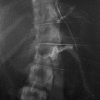High pressures and asymmetrical stresses in the scoliotic disc in the absence of muscle loading
- PMID: 17319969
- PMCID: PMC1820774
- DOI: 10.1186/1748-7161-2-4
High pressures and asymmetrical stresses in the scoliotic disc in the absence of muscle loading
Abstract
Background: Loads acting on scoliotic spines are thought to be asymmetric and involved in progression of the scoliotic deformity; abnormal loading patterns lead to changes in bone and disc cell activity and hence to vertebral body and disc wedging. At present however there are no direct measurements of intradiscal stresses or pressures in scoliotic spines. The aim of this study was to obtain quantitative measurements of the intradiscal stress environment in scoliotic intervertebral discs and to determine if loads acting across the scoliotic spine are asymmetric. We performed in vivo measurements of stresses across the intervertebral disc in patients with scoliosis, both parallel (termed horizontal) and perpendicular (termed vertical) to the end plate, using a side mounted pressure transducer (stress profilometry)
Methods: Stress profilometry was used to measure horizontal and vertical stresses at 5 mm intervals across 25 intervertebral discs of 7 scoliotic patients during anterior reconstructive surgery. A state of hydrostatic pressure was defined by identical horizontal and vertical stresses for at least two consecutive readings. Results were compared with similar stress profiles measured during surgery across 10 discs of 4 spines with no lateral curvature and with data from the literature.
Results: Profiles across scoliotic discs were very different from those of normal, young, healthy discs of equivalent age previously presented in the literature. Hydrostatic pressure regions were only seen in 14/25 discs, extended only over a short distance. Non-scoliotic discs of equivalent age would be expected to show large centrally placed hydrostatic nuclear regions in all discs. Mean pressures were significantly greater (0.25 MPa) than those measured in other anaesthetised patients (<0.07 MPa). A stress peak was seen in the concave annulus in 13/25 discs. Stresses in the concave annulus were greater than in the convex annulus indicating asymmetric loading in these anaesthetised, recumbent patients.
Conclusion: Intradiscal pressures and stresses in scoliotic discs are abnormal, asymmetrical and high in magnitude even in the absence of significant applied muscle loading. The origin of these abnormal stresses is unclear.
Figures











Similar articles
-
In vitro disc pressure profiles below scoliosis fusion constructs.Spine (Phila Pa 1976). 2008 Sep 15;33(20):2134-42. doi: 10.1097/BRS.0b013e31817d1d7f. Spine (Phila Pa 1976). 2008. PMID: 18794754
-
The internal pressure and stress environment of the scoliotic intervertebral disc--a review.Proc Inst Mech Eng H. 2008 Feb;222(2):209-19. doi: 10.1243/09544119JEIM303. Proc Inst Mech Eng H. 2008. PMID: 18441756 Review.
-
Electrochemical measurement of transport into scoliotic intervertebral discs in vivo using nitrous oxide as a tracer.Spine (Phila Pa 1976). 2001 Apr 15;26(8):984-90. doi: 10.1097/00007632-200104150-00028. Spine (Phila Pa 1976). 2001. PMID: 11317125 Clinical Trial.
-
ISSLS prize winner: a study of effects of in vivo mechanical forces on human lumbar discs with scoliotic disc as a biological model: results from serial postcontrast diffusion studies, histopathology and biochemical analysis of twenty-one human lumbar scoliotic discs.Spine (Phila Pa 1976). 2010 Oct 1;35(21):1930-43. doi: 10.1097/BRS.0b013e3181e9a156. Spine (Phila Pa 1976). 2010. PMID: 20838264
-
Elevated synthetic activity in the convex side of scoliotic intervertebral discs and endplates compared with normal tissues.Spine (Phila Pa 1976). 2001 May 15;26(10):E198-206. doi: 10.1097/00007632-200105150-00002. Spine (Phila Pa 1976). 2001. PMID: 11413439
Cited by
-
Proteomic Signatures of Healthy Intervertebral Discs From Organ Donors: A Comparison With Previous Studies on Discs From Scoliosis, Animals, and Trauma.Neurospine. 2020 Jun;17(2):426-442. doi: 10.14245/ns.2040056.028. Epub 2020 Jun 30. Neurospine. 2020. PMID: 32615701 Free PMC article.
-
A new method to include the gravitational forces in a finite element model of the scoliotic spine.Med Biol Eng Comput. 2011 Aug;49(8):967-77. doi: 10.1007/s11517-011-0793-4. Epub 2011 Jul 5. Med Biol Eng Comput. 2011. PMID: 21728065
-
Semiautomated 3D Spine Reconstruction from Biplanar Radiographic Images: Prediction of Intervertebral Loading in Scoliotic Subjects.Front Bioeng Biotechnol. 2017 Jan 20;5:1. doi: 10.3389/fbioe.2017.00001. eCollection 2017. Front Bioeng Biotechnol. 2017. PMID: 28164082 Free PMC article.
-
Is coronal imbalance in degenerative lumbar scoliosis patients associated with the number of degenerated discs? A retrospective imaging cross-sectional study.BMC Musculoskelet Disord. 2023 May 25;24(1):414. doi: 10.1186/s12891-023-06558-9. BMC Musculoskelet Disord. 2023. PMID: 37231434 Free PMC article.
-
Tracking low back pain in adolescent idiopathic scoliosis: a prospective cohort study protocol.Chiropr Man Therap. 2017 Sep 5;25:22. doi: 10.1186/s12998-017-0155-x. eCollection 2017. Chiropr Man Therap. 2017. PMID: 28878881 Free PMC article.
References
-
- GC R. The aetiology of idiopathic scoliosis. CRC Press; 1990.
-
- Andriacchi TP, Schultz AB, Belytschko TB, Dewald R. Milwaukee brace correction of idiopathic scoliosis. A biomechanical analysis and a restrospective study. J Bone Joint Surg Am. 1976;58:806–815. - PubMed
LinkOut - more resources
Full Text Sources

